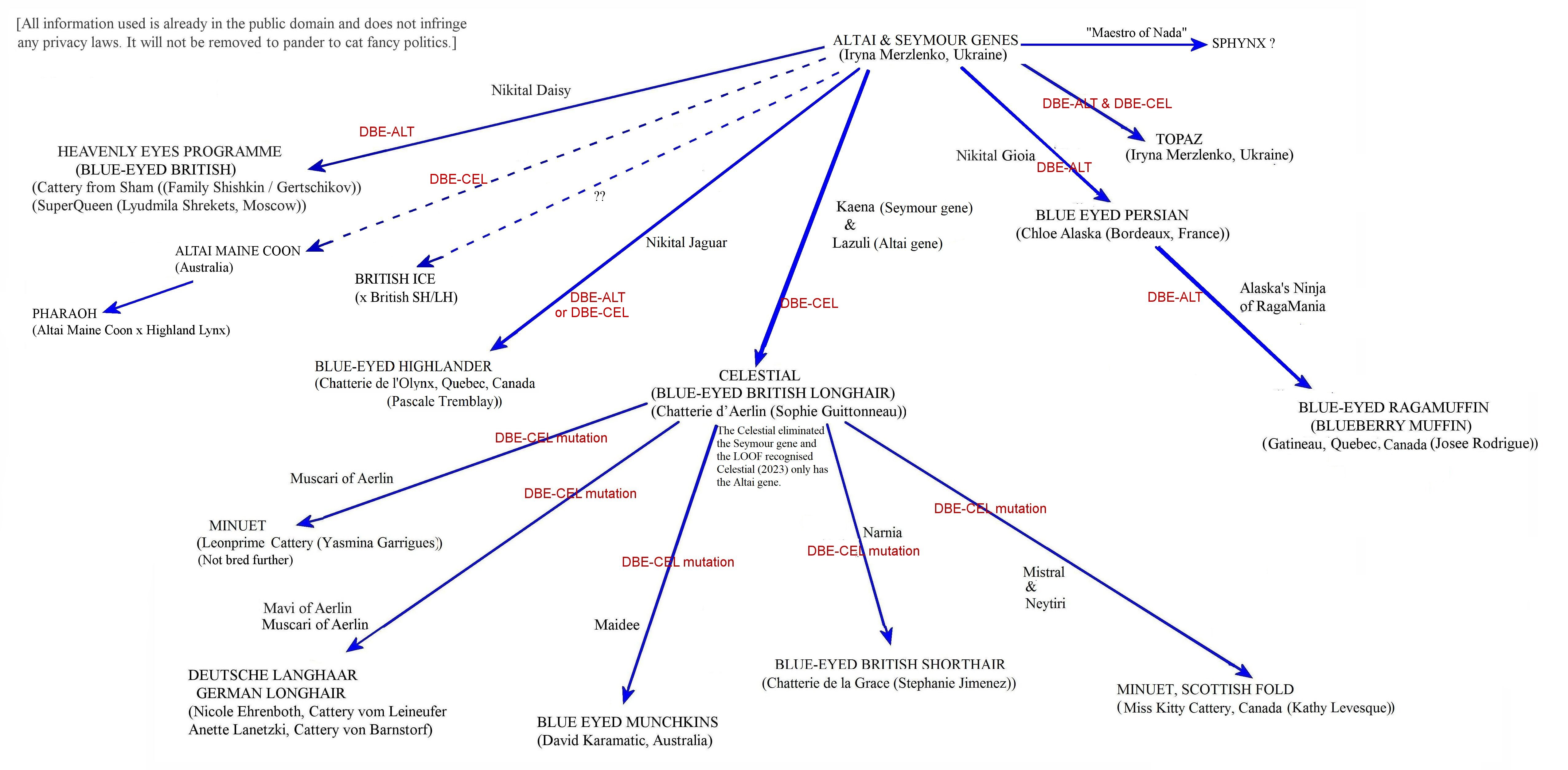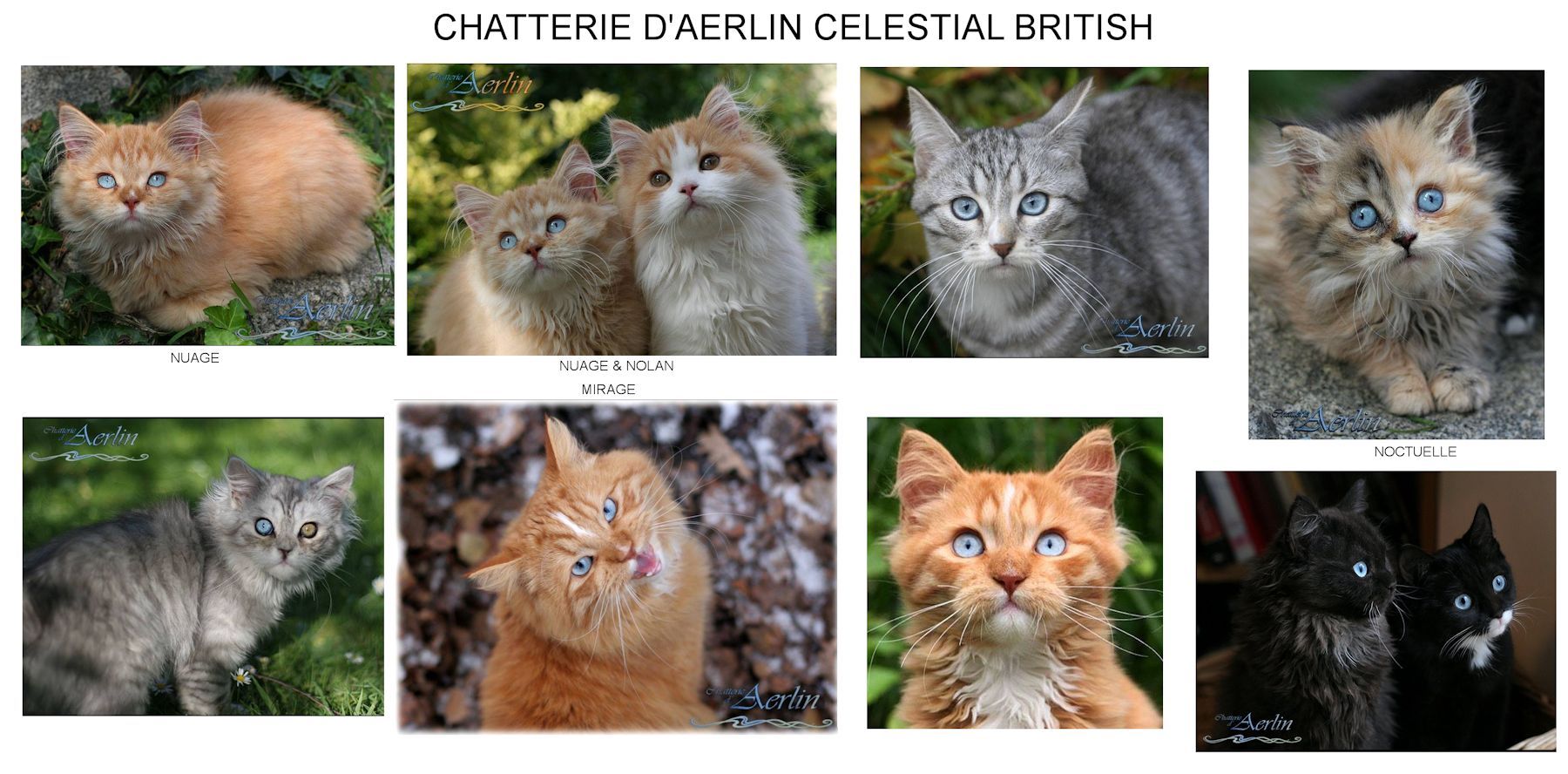
BLUE-EYED BREEDS - CELESTIAL (Altai Gene)
CELESTIAL
In August 2016, the LOOF (French registry) Committee of Standards approved the introduction of the blue eye colour in the British Shorthair/Longhair by Chatterie d'Aerlin (Sophie Guittonneau) and Chatterie de la Grace (Stephanie Jimenez) (Chatterie de la Grace left the Celestial breeding programme later on). In 2017, the partipating breeders included Lazycat Compagni (Vanessa Marmolejo), Vivarnon Cattery (Ghislaine Michel-Paulsen) and Chatterie les Gummis en Sucre (Sylvie Huber). The blue-eyed cats used were considered European Shorthairs and the progeny of the matings to British Shorthair/Longhair cats were registered as XSLH or XLH (experimental SH/LH). All the blue eyed kittens born at Aerlin cattery are tested with BAER for hearing because deafness was observed in cats with white faces and heads; this was caused by the interaction of the Seymour and Lazuli genes before the Seymour gene was removed from the gene pool by selective breeding (initially they were thought to be homozygotes, but this was not the case). No deaf cats are used in further breeding.
The Celestial initially included the Seymour gene, but breeders did not perpetuate those lines and only bred from Lazuli's descendants with the DBECEL gene (identified in 2024 by Marie Abitbol, previously known by breeders as the Altai gene). This avoided the production of deaf high white kittens.
In October 2015, the black smoke Altai "Lagoon" died of pneumonia before joining Chatterie d'Aerlin from Ukraine so her black smoke sister, "Kaena" was sent instead. Kaena was not blue-eyed (light green eyes) but carried the incompletely dominant gene and would produce blue-eyed kittens when mated to "Lazuli" from the same breeder in Ukraine. Kaena expressed the Altai blue-eye gene in a minimal way - a white locket, white belly spot, some white whiskers and the light green eyes. Kaena's sire had blue eyes. Lazuli was a brown mackerel tabby, with one green eye and one blue eye, from a blue-eyed sire. He carries longhair and is negative for the white spotting gene.

January 2016 - Lazuli x Igritte (cinnamon tortie BSH) produced 6 kitten, two of which expressed the Altai gene: Mirage of Aerlin, blue-eyed red self male (genetically mackerel tabby) and Muscari odd-eyed red mackerel tabby long-haired male, longhaired. The other 4 kittens were red males, "Mermite" and Mogwai" (longhaired), "Maya" - black tortie female and "Malice," long-haired brown tabby female.
18 July 2016: Kaena x Lazuli produced 7 kittens including 2 homozygotes: "Matcha" - black longhair males, not blue-eyed. "Merlin" black longhair with two blue eyes and white spots on the nose, back legs and tip of the tail. "Mavi" - A female black smoke longhair with a large white marking on the face and two blue eyes. "Mistral" - silver tabby male with white spots on the forehead, legs and tip of the tail, and blue eyes. "Ma di " - female brown tabby without white or blue eyes. "Miyuki" - a solid white longhair with a few coloured hairs in the lower back, and blue eyes (homozygote, deaf, not bred from). "Mochi" - bicolour mostly white, with a big colored spot on the lower body and blue eyes (homozygote, not deaf) this is the pattern known as "panda pattern" in the Topaz breed that was developed from Altai cats.
In August 2016 Ilvy Freyja of Preston (copper-eyed black British Longhair female b. October 2010) x Lazuli produced 4 kittens. Matahina of Aerlin (female) was solid black with a small white locket and odd eyes, but sadly died. Ma dee (female) was a black longhair with a white marking on the upper lip and blue eyes - she has gone to David Karamatic in Australia to introduce blue eyes into his solid colour Munchkins. Mauve (female) was a black female shorthair with white lips and chin, and two blue eyes. Monky was a brown spotted tabby shorthair male with non-blue-eyes. Mauve d'Aerlin went to Chatterie de la Grace to continue the breeding programme.
In April 2017 Lamu (Tortie BSH) x Muscari produced 3 red kittens, 1 black and 1 chocolate torbie - 4 of which had the coveted blue eyes. Also in 2017, Ilvy x Muscari produced 2 blue-eyed kittens and one non-blue-eyed. The charts below are from informatin kindly provided by the breeders.
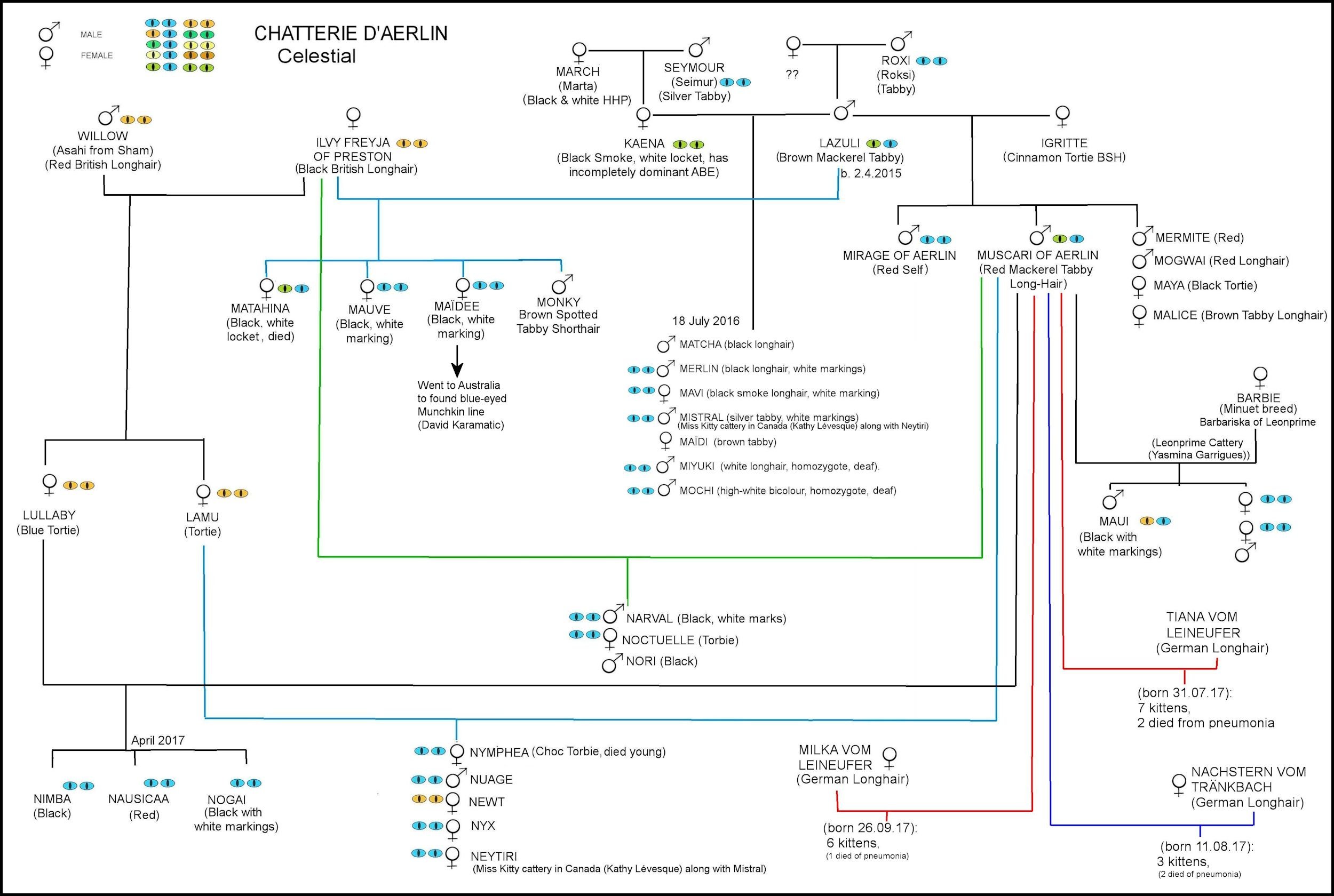
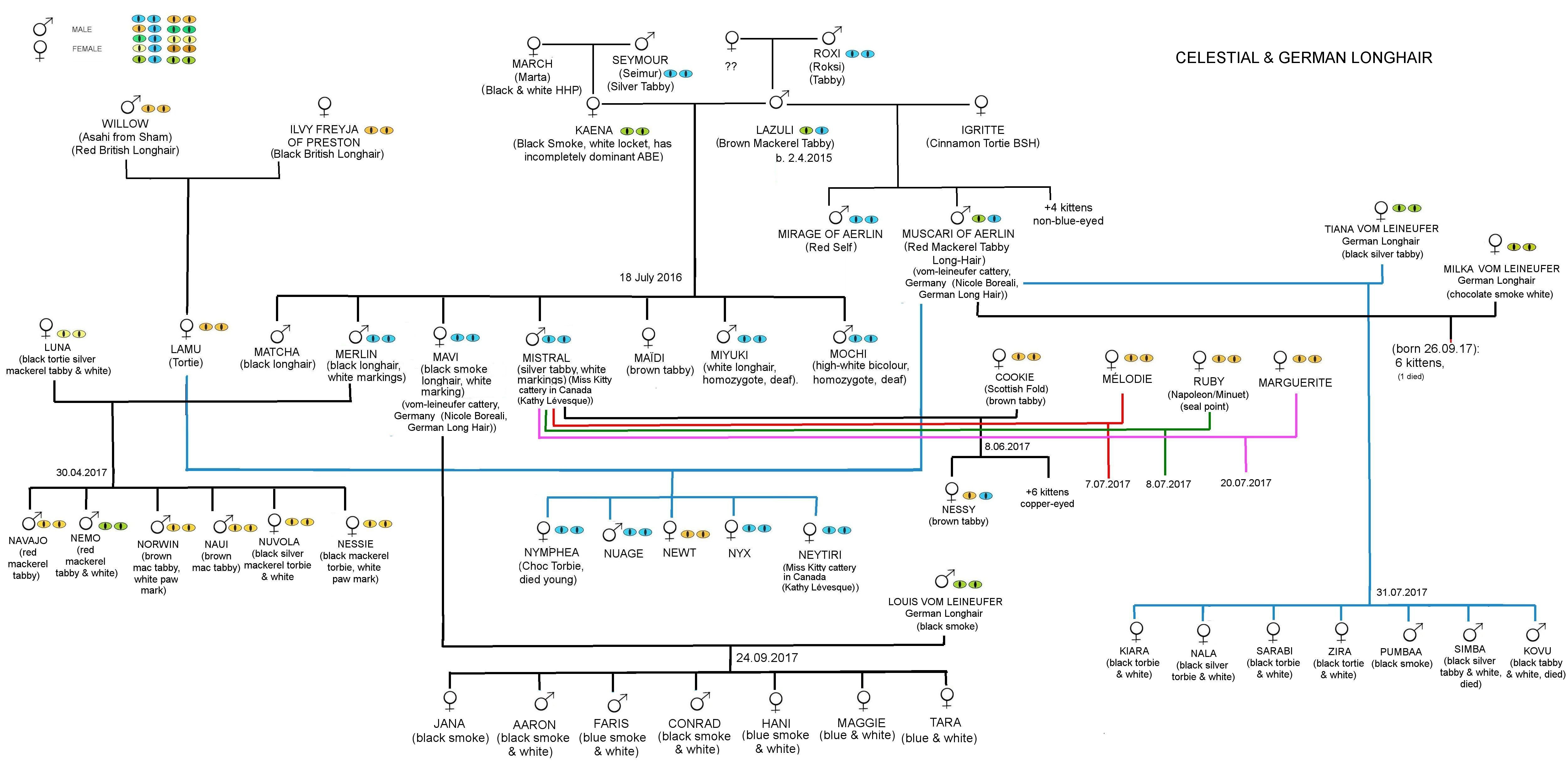
In 2019, a few years before the recognition of the Celestial as a new breed, a new Celestial line was planned using Jimmy Azure Dream (odd-eyed red bicolour shorthair Altai gene cat) as its foundation. Jimmy is descended from a female BRI x DBE male (possibly Altai gene) cat from Kazakhstan. Jimmy was sired by a blue-eyed bicolour found in Kazakhstan. This bicolour cat went to the Ukrainian breeder Natalya Lebedenko (Azure Dream cattery) where he was named Igor Azure Dream. Igor became the founder of numerous DBE lines, mainly British Shorthairs/Longhairs. His son Jimmy Azure Dream joined the Celestial breeding programme, but the French LOOF registry refused to recognise his progeny because Igor Azure Dream was unrelated to the Altai cats that produced Lazuli. LOOF declared that all Celestials must be descended from Lazuli so the "new line" automatically lost its status as a recognized line because it was potentially based on a different gene from a domestic cat of unknown origin. Jimmy's descendants would have to be bred to Lazuli's descendants for them to be recognised as valid Celestials.
In 2023, the Celestial was recognised by LOOF (French registry).
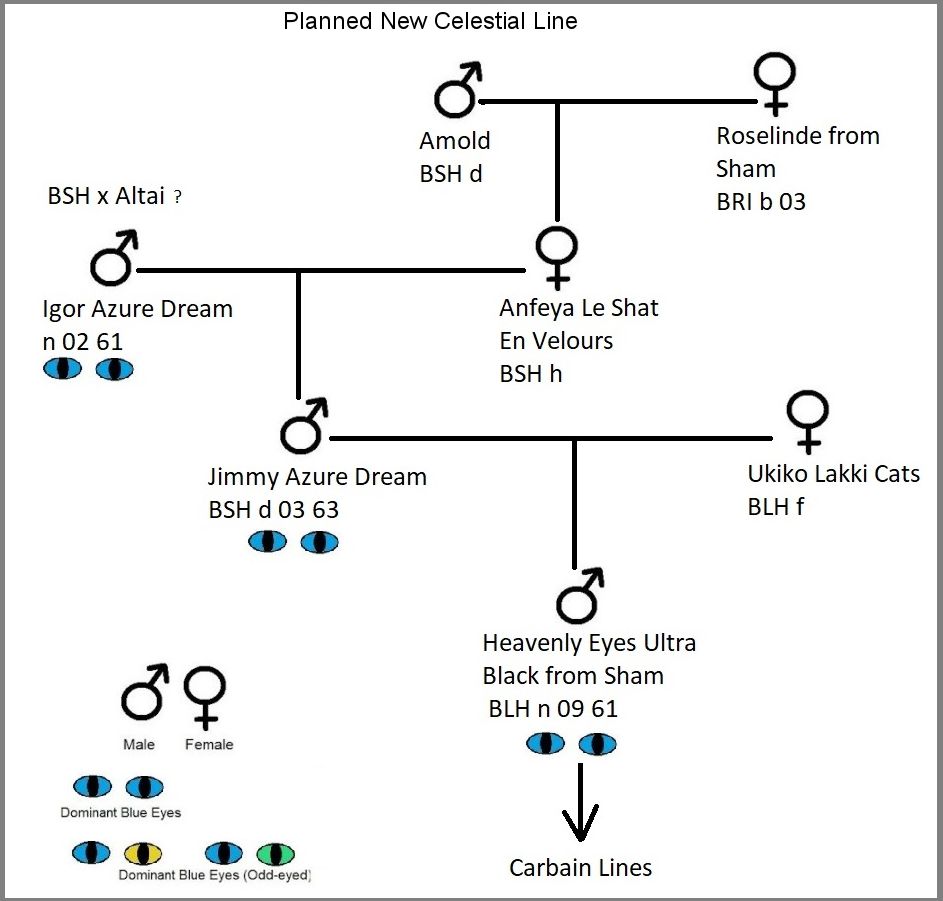
GENETICS - DBECEL GENE
A PAX3 INSERTION IN THE CELESTIAL BREED AND CERTAIN FELINE BREEDING LINES WITH DOMINANT BLUE EYES
Marie Abitbol, Alice Couronne, Caroline Dufaure de Citres, Vincent Gache
Animal Genetics. 2024;00:1–6., 9 April 2024
The authors found that a mutation of Paired Box 3 (PAX3) on chromosome C1 causes the minimal white spotting (sometimes no visible white spotting) and dominant blue eyes (DBE) in the French Celestial breed. PAX3 is a key regulator of MITF (Melanocyte-Inducing Transcription Factor) and PAX3 mutations cause white spotting with or without blue eyes in other species. An endogenous retrovirus LTR (long terminal repeat) insertion within PAX3 intron 4 was found.
All 52 Celestial and Celestial-mixed cats with the DBE phenotype had the mutation. Their 22 non-DBE littermates and 87 non-DBE cats from various breeds (control samples) did not have the mutation. The Celestial founder, Roxi, was heterozygous for the mutation. It was also found in 9 DBE Maine Coon cats related to Roxi and four DBE Siberian cats with an uncertain origin. The mutation shows a dominant inheritance pattern and is not to associated with deafness. It has been termed DBECEL (Celestial Dominant Blue Eyes) and originated from Roxi. Another Topaz founder, Seymour, does not have the DBECEL mutation; Seymour's mutation has yet to be determined.
Kittens with minimal white spotting and no blue eye but with a red-eye effect during infancy are known as latents (LBE). Latent cats possess the DBECEL mutation without expressing the blue eye phenotype. The French registry LOOF place restrictions on the Celestial breeding program: all British Shorthair/Longhairs used in breeding must test negative for white gloving, white spotting, and dominant white alleles (all are KIT gene mutations). Colourpoint and silver gene (inhibitor) cats are also not allowed to breed. Because of existing concerns linked to blue eyes and white spotting/masking, DBE Celestials have been tested for deafness. Out of 47 DBE Celestial cats tested, there were 3 cases of deafness and these were on one side only. These cats had medical histories of ear problems unrelated to DBE.
PAX3 mutations in humans are associated with Waardenburg syndrome characterised by a white forelock, premature greying, deafness and heterochromia or brilliant blue eyes. No auditory or premature greying is been found in the Celestial breed. [Sarah's note: these were found when 2 different genes were bred together in the Topaz. The Seymour gene is no longer in Celestial cats]
DBE in the Celestial breed is an autosomal dominant trait with variable expression and incomplete penetrance for both white spotting and blue eyes, and pleiotropy (the gene affects other processes in the organism, and tissue development in the embryo). A single Celestial DBE x DBE mating was performed, resulting in three healthy kittens and a presumed homozygous white kitten that died from cleft palate just after birth.
